Drive Angry (2010)

Introducing Drive Angry (2011): A High-Octane Dive into Exploitation Cinema
Overview
Drive Angry (also known as Drive Angry 3D), released on February 25, 2011, is an American action horror film that embraces the gritty, over-the-top aesthetic of exploitation cinema. Directed by Patrick Lussier and co-written by Lussier and Todd Farmer, the film stars Nicolas Cage as a vengeful father who escapes from Hell to save his granddaughter from a satanic cult. With its blend of supernatural elements, high-octane car chases, and unapologetic violence, Drive Angry is a love letter to the grindhouse films of the 1970s, complete with 3D effects designed to amplify its chaotic energy. While not a critical or commercial blockbuster, the film has garnered a cult following for its audacious style and Nicolas Cage’s larger-than-life performance.

Plot Summary
Drive Angry centers on John Milton (Nicolas Cage), a hardened felon who breaks out of Hell after stealing Satan’s powerful weapon, the Godkiller, to pursue Jonah King (Billy Burke), a charismatic but ruthless cult leader. King murdered Milton’s daughter and her husband and kidnapped their infant daughter, planning to sacrifice her in a ritual to unleash Hell on Earth. Milton, driven by rage and a desire for redemption, has three days to stop the ritual before he is dragged back to Hell by the Accountant (William Fichtner), a relentless supernatural enforcer sent by Satan to retrieve him.
Milton’s journey takes him to a diner in Colorado, where he meets Piper Lee (Amber Heard), a tough-as-nails waitress with her own troubles. After a violent encounter, Piper joins Milton, lending him her red Dodge Charger for the high-speed pursuit to Stillwater, an abandoned Louisiana prison where the ritual is set to occur. Along the way, they face King’s fanatical followers, engage in explosive action sequences, and uncover Milton’s tragic backstory. The film’s most memorable scene involves Milton engaging in a gunfight while mid-coitus, smoking a cigar and wearing sunglasses, encapsulating the film’s unapologetic excess. The narrative builds to a climactic showdown, blending supernatural stakes with gritty revenge, culminating in a resolution that balances Milton’s quest for justice with his own damned fate.
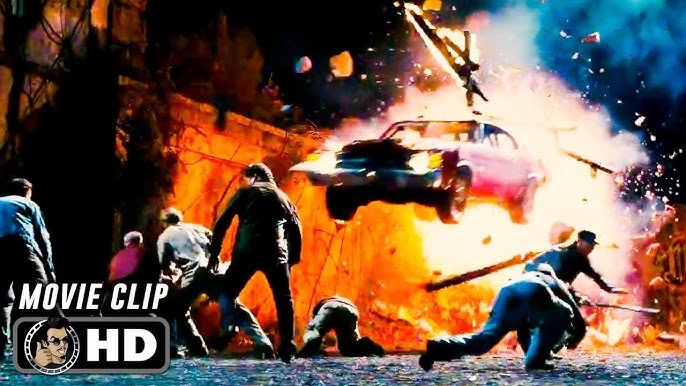
Themes and Symbolism
Drive Angry is steeped in the tropes of exploitation cinema, with themes of vengeance, redemption, and the battle between good and evil. The film explores Milton’s quest for redemption through his mission to save his granddaughter, reflecting a classic antihero archetype who is both damned and driven by a moral cause. The supernatural elements, including Milton’s escape from Hell and the Accountant’s pursuit, add a layer of cosmic justice, suggesting that even in a world of chaos, there are rules governing retribution.
The film also delves into the dangers of fanaticism, embodied by Jonah King’s cult, which uses charisma and violence to manipulate its followers. This critique of blind devotion is juxtaposed with Milton’s single-minded determination, highlighting the fine line between righteous vengeance and destructive obsession. The use of cars, particularly Piper’s Dodge Charger, serves as a symbol of freedom and power, a nod to the car-centric culture of grindhouse films where vehicles are extensions of their drivers’ identities.
Gender dynamics are present, though less nuanced, with Piper representing a strong, independent female character who contrasts with the film’s more exploitative depictions of women. The film’s embrace of excess—violence, sex, and profanity—serves as both a stylistic choice and a commentary on the allure of transgression in exploitation cinema, inviting audiences to revel in its absurdity while acknowledging its moral undertones.
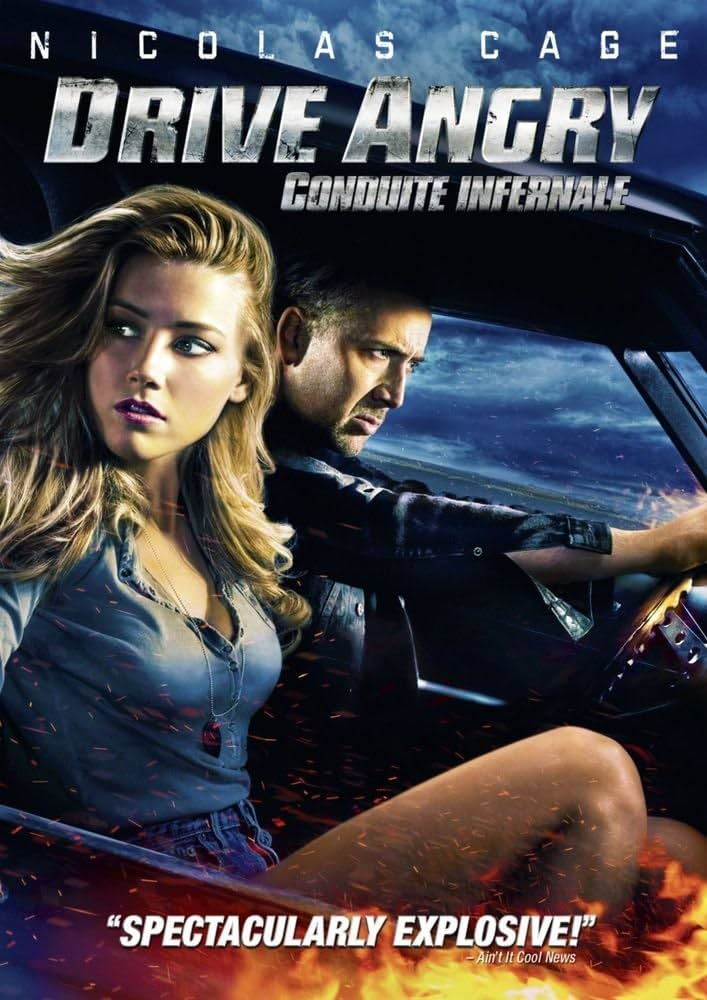
Cast and Performances
Drive Angry boasts a colorful ensemble led by Nicolas Cage as John Milton. Cage delivers a performance that is quintessentially over-the-top, blending intense gravitas with moments of campy humor, making Milton both a tragic figure and a larger-than-life action hero. Amber Heard’s Piper Lee is a fiery counterpart, bringing grit and charisma to a role that could have been one-dimensional, though critics noted her performance was limited by the script’s lack of depth.
William Fichtner steals the show as the Accountant, a sardonic and relentless enforcer whose dry wit and menacing presence make him a standout. Billy Burke’s Jonah King is suitably menacing, playing the cult leader with a blend of charm and depravity, while supporting actors like David Morse (as Webster, Milton’s old friend), Charlotte Ross, and Katy Mixon (as Norma Jean, a diner worker) add texture to the film’s world. Tom Atkins also appears in a small but memorable role, adding a nod to horror fans familiar with his work in films like Halloween III.
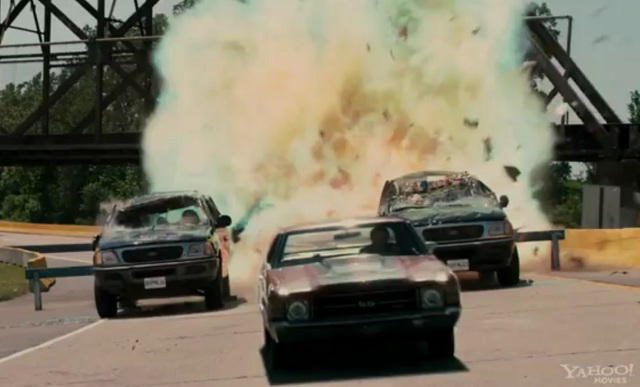
Direction and Production
Directed by Patrick Lussier, known for horror films like My Bloody Valentine 3D (2009), Drive Angry leans heavily into its grindhouse influences, with a deliberate emphasis on practical effects, real stunts, and 3D cinematography. Lussier, who co-wrote the script with Todd Farmer, aimed to create a film that was “tastefully tasteless,” balancing intentional humor, violence, and sleaze. The decision to shoot in 3D, rather than rely on post-production conversion, was a point of pride for Lussier, who believed it enhanced the film’s visceral impact.
The production, with a budget of approximately $50 million, was shot primarily in Louisiana, with locations chosen to evoke the gritty, desolate aesthetic of the American South. Cinematographer Brian Pearson captured the film’s high-energy action sequences, including car chases and shootouts, with a focus on practical effects and real stunts to maintain authenticity. The film’s score, composed by Michael Wandmacher, blends hard rock guitar riffs with southern and horror-inspired cues, complementing the film’s tone and enhancing its genre appeal.
The production faced challenges in balancing its grindhouse aspirations with mainstream appeal. Originally, Milton was envisioned as a 70-year-old man, but Cage’s casting shifted the character to a more ageless, mythic figure. The script underwent revisions to trim humor, which some critics argued left the film feeling too serious for its absurd premise. Despite these challenges, the production team’s commitment to practical effects and 3D shooting created a visually striking experience that stood out in an era dominated by post-converted 3D films.
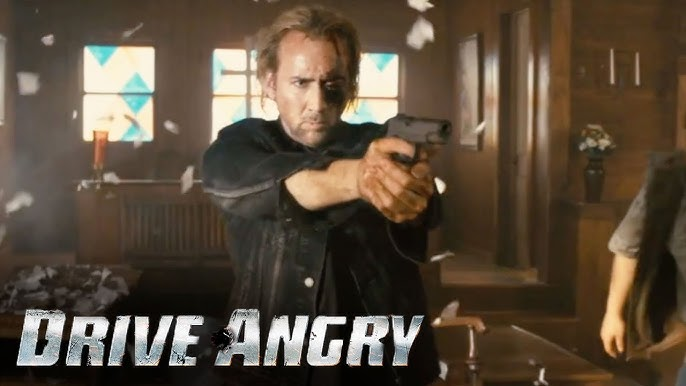
Critical Reception
Drive Angry received mixed reviews upon release, with a 47% approval rating on Rotten Tomatoes based on 123 critics and an average score of 5.4/10. The consensus noted that while the film delivers “over-the-top action pieces,” it “prefers to work safely within the grindhouse formula than do something truly unique”. Critics praised the film’s unapologetic energy, with Roger Ebert noting its “muscle car racing across a burning bridge out of Hell” as a bold opening that sets the tone for its audacity. William Fichtner’s performance as the Accountant was widely lauded, with many calling him the film’s highlight.
However, some reviewers criticized the film for its lack of humor and uneven tone, arguing it didn’t fully embrace the campy spirit of true grindhouse classics like Grindhouse or Slither. The dialogue was often cited as weak, and some felt Nicolas Cage’s performance, while entertaining, lacked the unhinged energy of his most iconic roles. The film’s box office performance was disappointing, opening at ninth place with a $5 million weekend, the lowest-grossing opening for a 3D film released in over 2,000 U.S. theaters. It ultimately earned $30.3 million internationally against its $50 million budget, marking it as a commercial failure.

Cultural Impact and Legacy
Drive Angry occupies a niche place in modern cinema, appealing to fans of exploitation films and Nicolas Cage’s eclectic career. Its release came during a period when Cage was balancing mainstream and offbeat projects, and the film is often cited as an example of his willingness to embrace “cinematic self-immolation”. While not a critical or commercial success, it has found a cult audience, particularly among those who appreciate its grindhouse homage and over-the-top sequences, such as the infamous sex-and-gunfight scene.
The film’s use of 3D was notable at the time, as it was shot natively in 3D rather than converted in post-production, a choice that aligned with Lussier’s vision of delivering a visceral, in-your-face experience. This commitment to practical effects and real stunts also resonated with fans of action cinema, drawing comparisons to films like Piranha 3D and Machete. The film’s soundtrack, with its rock-heavy score, has been praised for its genre-appropriate energy and is available for fans to revisit.
Drive Angry also sparked discussions about a potential sequel, with ideas floated about Milton avenging the Devil’s murder, though no such project materialized due to the film’s poor box office performance. Its legacy lies in its unapologetic embrace of excess, serving as a testament to the enduring appeal of grindhouse-style storytelling and Nicolas Cage’s unique screen presence. The film is available on streaming platforms like Peacock and has been released on DVD, Blu-ray, and 3D Blu-ray, allowing new audiences to discover its chaotic charm.
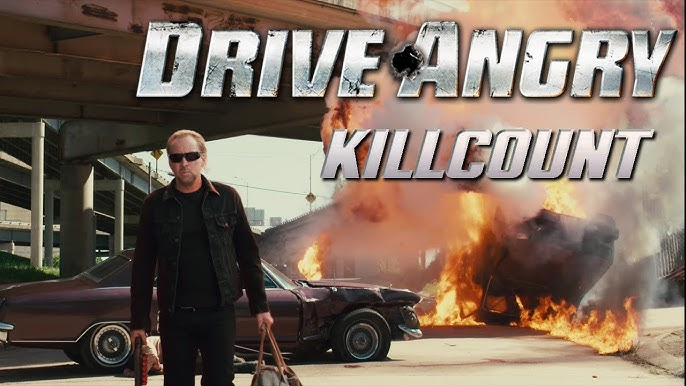
Conclusion
Drive Angry (2011) is a wild, unapologetic ride that channels the spirit of 1970s exploitation cinema through a modern lens. With Nicolas Cage leading a talented cast, Patrick Lussier’s direction, and a commitment to practical effects and 3D spectacle, the film delivers a mix of supernatural thrills, high-octane action, and grindhouse excess. While its mixed critical reception and commercial struggles prevented it from achieving mainstream success, its cult status and bold choices make it a memorable entry in the action-horror genre. For fans of Nicolas Cage, grindhouse aesthetics, or adrenaline-pumping chaos, Drive Angry is a thrilling, if flawed, cinematic experience that refuses to play it safe.